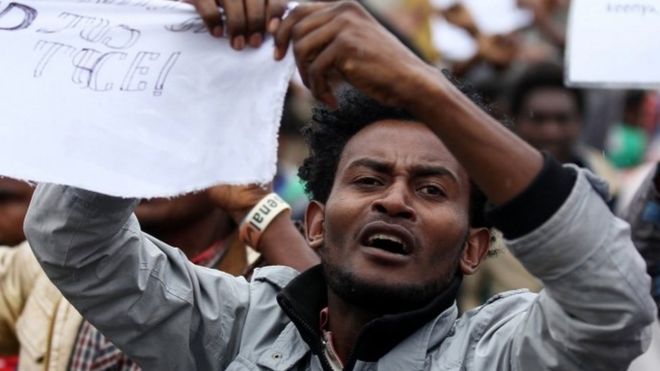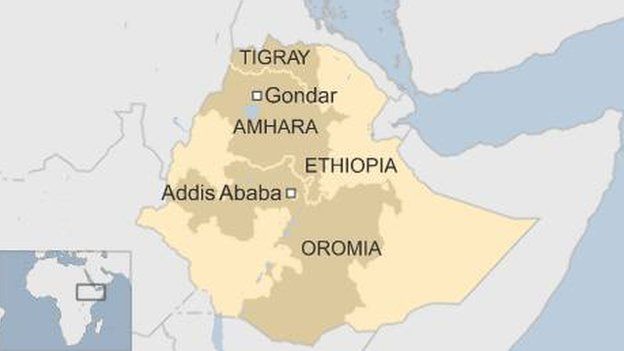 Oromo protesters took to the streets of the capital, Addis Ababa, on Saturday
Oromo protesters took to the streets of the capital, Addis Ababa, on Saturday
Ethiopia's government normally keeps a tight grip on the country but has been unable to prevent a wave of protests in recent months. There has not been anything on this scale in the last 25 years.
They began in the Oromia region last November but have now sprung up in the Amhara region - the homelands of the country's two biggest ethnic groups.
Activists say dozens of people were killed in Oromia, as security forces clashed with the demonstrators, along with seven in Amhara, although the Oromia deaths have not been confirmed.
In response to the protests, the government shut down the internet for two days.
Why now?
There has not been a specific trigger and what we are seeing is an accumulation of years of frustration from ethnic groups who say they have been marginalised by the government.
Protesters in the Amhara region - from the Welkait community - first took to the streets of the city of Gondar in July over a land issue.
New York-based Human Rights Watch says that more than 400 people have been killed in clashes with the security forces in Oromia, although the government disputes this figure.
So what is behind this?

The Oromos, who make up around a third of the population, have long complained that they have been excluded from the country's political process and the economic development which has seen the capital, Addis Ababa transformed in recent years.
The recent protests were initially over a plan to expand the boundaries of Addis Ababa into the Oromia region.
That plan was dropped, but the demonstrations exposed some underlying issues and protests continued with the latest round taking place on Saturday in many places in Oromia and the capital, Addis Ababa.
At the root of the recent demonstrations in Amhara is a request by representatives from the Welkait Amhara Identity Committee that their land, which is currently administered by the Tigray regional state, be moved into the neighbouring Amhara region.
The Welkait committee says community members identify themselves as ethnic Amharas and say they no longer want to be ruled by Tigrayans.
Amharas used to form the country's elite and the language, Amharic, remains the most widely spoken in the country.
Ethiopia's ethnic make-up
- Oromo - 34.4%
- Amhara - 27%
- Somali - 6.2%
- Tigray - 6.1%
- Sidama - 4%
- Gurage - 2.5%
- Others - 19.8%
Source: CIA World Factbook estimates from 2007
Is there a connection between the protest movements?

Observers say that Ethiopia's governing coalition is dominated by the party from the small Tigray region (TPLF), that led the guerrilla war against the military regime of Colonel Mengistu Haile Mariam. Some see both sets of protests as a way of criticising the country's government.
There is no formal connection between the Amhara and Oromia demonstrations but at last week's protest in Gondar, banners could be seen expressing solidarity with people from the Oromia region.
Oromo activists referred to the demonstrations in Amhara in their Facebook post calling for Saturday's protests, but highlighted the fact that they thought the protesters there had been treated more leniently.
Is the government in trouble?
 AFP
AFP
The central government, a close ally of the West, is in a very powerful position and has total control over the security forces.
There is not a single opposition member in parliament, so it faces no real political threat.
But its reaction to the weekend's protests suggests that it is worried.
One of the first things it did was to shut down the internet across the country, fearing that that was how the demonstrations were being organised.
There is only one, state-controlled internet service provider so this was fairly straightforward.
This went way beyond the reaction to protests from other governments where access to certain social media sites has been restricted.
Last week, Prime Minister Hailemariam Desalegn issued a veiled threat to protesters saying that the government is obliged to ensure the rule of law. But he did not specify what that meant in practice.
He also appeared to be concerned that the country was sliding into ethnic conflict, which could become difficult to contain.
Correction: We have removed a reference to anti-government protests being rare in Ethiopia that appeared in a first version of this story
Source: BBC
No comments:
Post a Comment